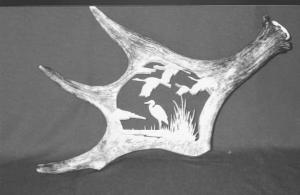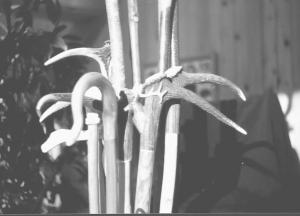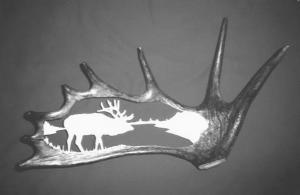2004 - Volume #28, Issue #5, Page #23
[ Sample Stories From This Issue | List of All Stories In This Issue | Print this story
| Read this issue]
Antlers Artist Adds Beauty To Nature
 |
 |
 |
The Scottish-born craftsman says antler carving is common in Scotland, where he learned it from his father.
It's very difficult getting the raw materials for his work, he says. He sometimes makes an exchange with hunters he meets at craft shows, whereby he offers to do a carving for them if they will provide him with a certain number of antlers they've harvested or found. He also gets a few from a zoo where he was once employed.
MacKendrick says his moose antler carvings are meant to be hung on the wall or to stand on a table. Some of the scenes he has created include herons flying through the clouds, a moose walking through the woods, a large bear with a mountain goat in the background and polar bears with a kayaker.
He uses a scroll saw to cut out the main shape, and then a hand-held drill to carve detail. Dentist bits and diamond bits are tools that provide the finishing touches.
"I first began carving about 20 years ago and, as I go along, I learn more techniques that make the work a bit easier," MacKendrick says. "It takes me about a month to complete a large moose antler carving."
Not one to waste his raw material, MacKendrick uses the cut out pieces to make letter openers, Christmas tree decorations, napkin rings, pendants, earrings and pins.
Elk antlers also make beautiful cribbage boards and he also makes traditional antler buttons, which are popular with Europeans who put them on their woolen sweaters.
Another of his specialties are walking sticks and shepherd's crooks made from spiral-shaped domestic sheep horns, with a hardwood or hazelwood shaft. MacKendrick learned this skill from his 90-year-old father who lives in England. It takes him about 100 hours to make a sheep horn walking stick.
He first boils the sheep horn to make it pliable enough to untwist. Once it has cooled, he uses dry heat from a propane torch, and a vice to compress the horn and close its hollow end. Next, he sands out the ridges and polishes the horn smooth. More dry heat allows him to make final changes to the horn's shape. A hole is drilled into the end of the horn and the stick shaft is pegged into that hole.
Since elk antler is too big for walking stick use, MacKendrick sometimes uses red deer, fallow deer, reindeer or caribou antler. This is trickier than sheep horn, because the shape can't be manipulated and he has to find ones that already have a suitable contour.
He sells his work each fall at a craft show in Winnipeg, and does custom orders. MacKendrick charges $60 and up (Canadian) for walking sticks, jewelry is $20 and up, and moose carvings are $150 and up.
Contact: FARM SHOW Followup, Graeme MacKendrick, Box 193, Balmoral, Manitoba, Canada R0C 0H0 (ph 204 467-9127; email: ghmtam@mb.sympatico.ca).

Click here to download page story appeared in.

Click here to read entire issue
To read the rest of this story, download this issue below or click here to register with your account number.




